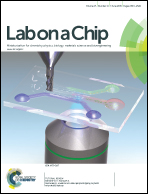Exosome isolation: a microfluidic road-map†
Abstract
Exosomes, first isolated 30 years ago, are nanoscale vesicles shed by most types of cells. The nucleic acid rich content of these nanoparticles, floating in virtually all bodily fluids, has great potential for non-invasive molecular diagnostics and may represent a novel therapeutic delivery system. However, current isolation techniques such as ultracentrifugation are not convenient and do not result in high purity isolation. This represents an interesting challenge for microfluidic technologies, from a cost-effective perspective as well as for enhanced purity capabilities, and point-of-care acquisition and diagnosis. In this frontier review, we present the current challenges, comment the first microfluidic advances in this new field and propose a roadmap for future developments. This review enables biologists and clinicians familiar with exosome enrichment to assess the performance of novel microfluidic devices and, equally, enables microfluidic engineers to educate themselves about this new class of promising biomarker-rich particles and the challenges arising from their clinical use.


 Please wait while we load your content...
Please wait while we load your content...